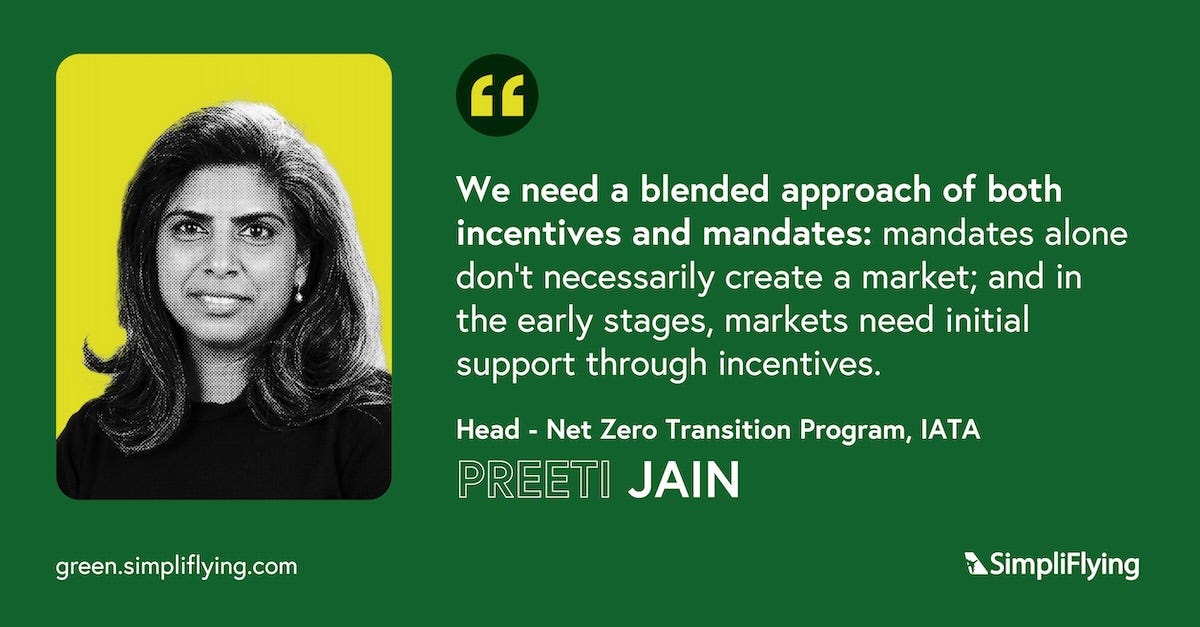In this first-ever bilingual episode of our ‘Sustainability in the Air’ podcast, Preeti Jain, Head of Net Zero Transition Program at the International Air Transport Association (IATA), speaks with SimpliFlying CEO Shashank Nigam and shares the challenges and opportunities in scaling up sustainable aviation fuel (SAF), to help aviation achieve its net zero goal by 2050.
Please note: The audio interview is presented in two parts: English followed by Hindi.
Here are the key highlights of the conversation:
Market dynamics and challenges (08:09)
Simplifying the concept of SAF feedstocks (12:08)
The cost of producing SAF (17:43)
Importance of government support and incentives (19:56)
The role of book and claim (27:04)
Rapid Fire! (45:39)
Part-II (in Hindi) (53:15)
Keep reading for a quick overview of the episode.
Why policies matter for accelerating SAF production
Government policy plays a critical role in adopting and scaling new technologies. Since there is a stark mismatch between the supply and demand of SAF – with the current demand outstripping supply – the need for policy support is even more crucial to rapidly scale SAF production.
To achieve this, Jain elaborates on IATA’s approach of adopting a blended policy strategy for SAF – incorporating a mix of incentives and mandates. She believes incentives like tax rebates, capital support, feedstock subsidies, and R&D programs are essential to boost SAF production, especially during the early stages of development. She commends the US Inflation Reduction Act, and California’s Low Carbon Fuel Standard as two great examples.
Jain also illustrates how incentives were instrumental in bringing down costs in the renewable energy sector, making renewable electricity affordable and more accessible. She hopes for a similar trajectory for SAF as the current price gap between SAF and Jet-A fuel is quite large – SAF is ~3-5 times more expensive than jet fuel.
She also acknowledges the role of mandates that impose minimum SAF uptake requirements, such as those put forth by the RefuelEU policy, in creating SAF markets and sending strong demand signals to producers. However, since SAF is still in its early stages, such mandates, IATA cautions, should “only be used if they are part of a broader strategy to increase the production of SAF and complemented with incentive programs that facilitate innovation, scale-up and unit cost reduction.”
Ultimately, Jain argues for a balanced and pragmatic approach to SAF policy that recognises the need for both incentives such as those in the US (“carrots”), and mandates such as those in Europe (“sticks”). She also emphasises the need for consistent and harmonised SAF policies across countries that are technology and feedstock agnostic.
5 takeaways from the conversation
1. The current SAF landscape
Jain estimates that a staggering 1000x increase in SAF production will be needed by 2050 to meet the industry’s decarbonisation targets. This would necessitate the construction of nearly 300 new SAF plants each year.
However, this rapid scale-up is hamstrung by several challenges:
Inconsistent and insufficient policy support for SAF in most regions.
The capital costs for new production facilities are quite high – ~$250 million per plant.
The feedstock supply chains are underdeveloped and not well-integrated.
Currently, the majority of SAF is produced via the HEFA pathway using fats, oils, and greases. Jain stresses the need for a wider range of production pathways and facilities utilising diverse feedstocks, to increase SAF production.
2. Technology and Costs
Building a new SAF plant is a capital-intensive endeavour, and can cost nearly $250 million for a 50-70,000 tonne/year facility. These costs, Jain believes, are expected to decline with more experience, technology learning, and integration with existing infrastructure.
In the near term, Jain sees significant potential in leveraging existing petroleum refining infrastructure to produce SAF through “co-processing”. This involves replacing small amounts of fossil feedstock (~5%) with bio-based feedstocks during fuel production.
As more facilities are deployed and technologies mature, Jain believes the price gap between SAF and Jet-A fuel will become narrower over time. The momentum for this cost reduction, however, would need to be built through targeted policies and investments in the early stages.
3. Book and claim
Book-and-claim is an accounting process that allows SAF to be produced in a different location from where it is used. This allows the fuel to be used where it is most practical while enabling end-users such as airlines to claim the associated emission reductions. Ultimately, this facilitates SAF production to be optimised for cost and logistics while still benefiting participating airlines.
Jain emphasises that book-and-claim opens up the SAF market despite regional limitations and local aviation sector constraints. She believes it will be a game-changer in the industry's efforts to scale up SAF use and achieve net zero emissions.
“[Book and claim] gives equal footing and equal opportunity to all airlines. More importantly, stakeholders need not be limited by geography… it’s basically opening a market of SAF despite the regional limitations or the local aviation sector traffic limitations.”
4. Role of airlines and customers
Airlines can help create the market pull needed to drive greater SAF production by adopting and committing to the use of SAF, and actively engaging customers in the process. Despite razor-thin margins, many airlines are already increasing SAF usage, with more than 40 airlines signing offtake agreements, says Jain.
Some airlines are also beginning to offer customers the opportunity to voluntarily pay for SAF to offset the emissions on their individual flights, either through direct purchase or by contributing to airline-led SAF programs.
“[Airlines] are already on a campaign to educate customers and create awareness around it. When you bring the environment into the public eye, that change is destined to happen. With the aviation sector, we are seeing that that start has already been made.”
5. Opportunities in emerging economies
Jain argues that there’s huge potential for emerging economies to develop domestic SAF industries using locally available feedstocks. Countries like Brazil or India that generate massive quantities of crop residues and byproducts, could use them for producing SAF with the right policy support and investment in infrastructure.
Developing these SAF value chains will aid emissions reduction, rural economic development, and improved waste management, Jain explains. Moreover, she believes SAF can offer important energy security benefits for these countries as well.
‘Sustainability in the Air’ is the world’s leading podcast dedicated to sustainable aviation. Through in-depth conversations with top aviation leaders, we break through the clutter and provide a clear roadmap for a net-zero future.















